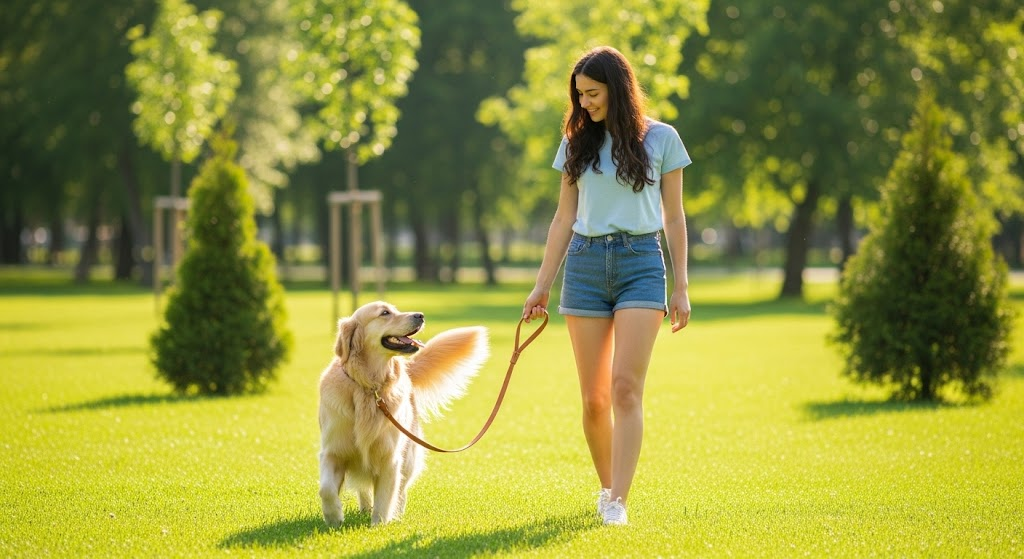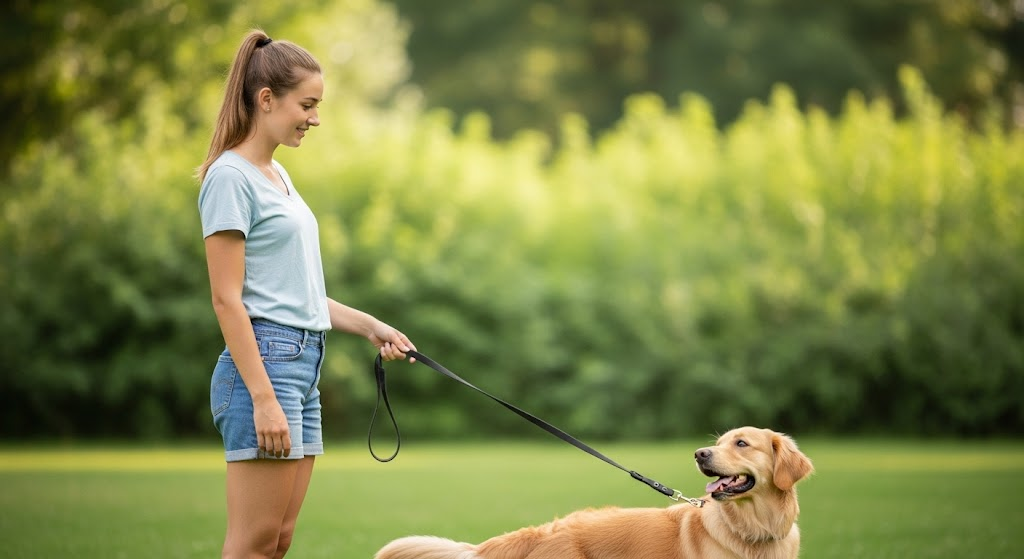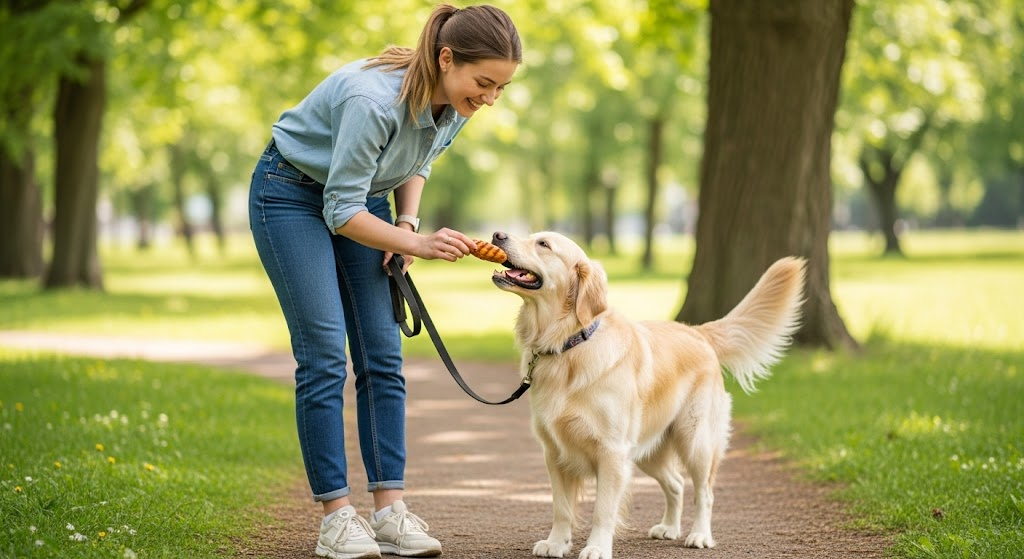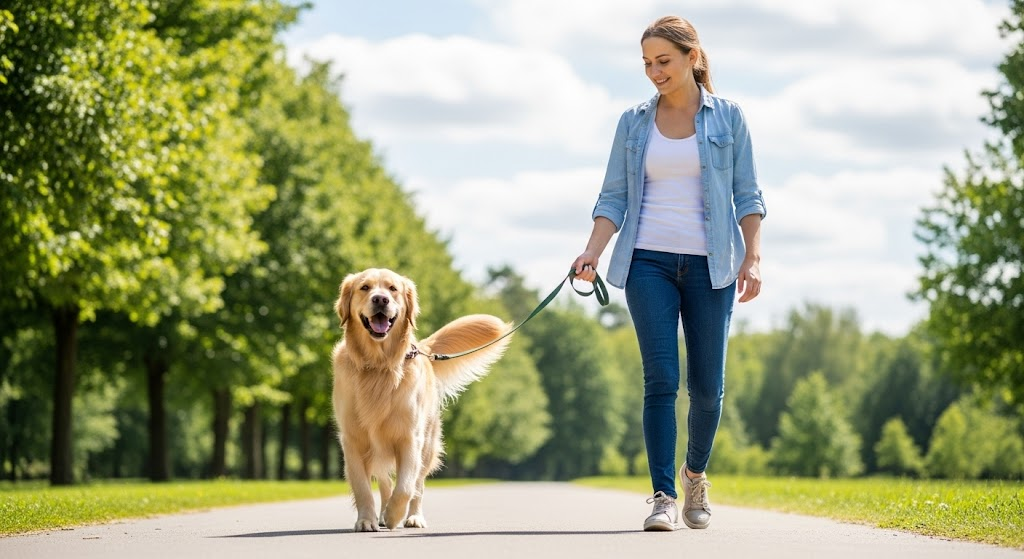
How to Stop Dog Leash Pulling: A Guide to Enjoyable Walks
Few things are more frustrating for a dog owner than a walk that feels like a tug-of-war. Instead of a relaxing stroll, you’re dragged down the street, your arm aches, and your dog seems oblivious to your pleas. If you’ve ever found yourself wondering, “How do I stop my dog from pulling on the leash?”, you’re not alone. This common canine behavior can make daily walks a chore rather than a joy.
This comprehensive guide explains why dogs pull, the right tools to use, and proven positive reinforcement techniques on how to stop dog leash pulling, while also teaching your dog proper leash manners, transforming your walks into enjoyable outings.
Why Do Dogs Pull on the Leash?
Before you can stop leash pulling, it’s crucial to understand why dogs engage in this behavior. It’s rarely about disobedience; often, it’s rooted in instinct and learned habits.
- Natural Instincts: Dogs naturally walk at a faster pace than humans. They are also driven by their noses and a desire to explore the world ahead of them. In their natural world, the “leader” often goes first, and if they perceive a vacuum in leadership, they’ll instinctively take that role.
- Excitement and Excess Energy: A dog that hasn’t had enough physical or mental stimulation may be overly excited by the prospect of a walk. This pent-up energy often manifests as frantic pulling to get to every smell, person, or other dog.
- Lack of Training or Inconsistent Training: If a dog has never been taught how to walk politely on a leash, or if the training has been inconsistent, they learn that pulling is an effective way to get what they want – forward momentum.
- Reinforcement of Pulling: Every time your dog pulls and gets to sniff that bush, greet that person, or reach the park, their pulling behavior is reinforced. They learn: “If I pull, I get to go there faster!”

Essential Equipment for Loose-Leash Dog Training
Choosing the right equipment can significantly aid your training efforts, providing better control and comfort for your dog.
- Flat Collars vs. Training Tools: While a flat collar is standard, it offers little leverage against a determined puller and can put strain on your dog’s neck. For dogs that pull, specialized training tools are often more effective.
- Front-Clip Harnesses: These harnesses have the leash attachment point on your dog’s chest. When your dog pulls, the leash pressure gently turns them to the side, redirecting their forward momentum. This discourages pulling without causing discomfort. Popular examples include the Freedom Harness and Easy Walk Harness.
- Head Halters (Gentle Leader/Halti): Similar to horse halters, these loop over your dog’s muzzle and behind their ears, with the leash attaching under the chin. They work on the principle that where the head goes, the body follows. Head halters offer excellent control and can be very effective for strong pullers, as they distribute pressure across the head rather than the neck.
- Avoid Aversive Tools: At Dan Gentile Dog Training Center, we advocate for positive, humane training methods. We strongly advise against using choke chains, prong collars, or any other tool that causes pain or fear. These can damage your dog’s neck, create negative associations with walks, and worsen behavioral issues.
- Leash Choice: A standard 4-6 foot leash made of nylon, leather, or biothane is ideal. Avoid retractable leashes, as they actually teach your dog to pull by providing more line every time they exert force, constantly reinforcing the unwanted behavior.
Core Principles of Loose-Leash Walking Training
Effective leash training relies on a few fundamental principles:
- Positive Reinforcement is Key: Reward the behaviors you want to see! When your dog walks nicely on a loose leash, immediately praise them and offer a high-value treat. This teaches them that walking calmly next to you yields positive outcomes.
- Consistency and Patience: Loose-leash walking is a learned skill that takes time, consistency, and patience. Short, regular training sessions (5-10 minutes, several times a day) are far more effective than infrequent, long ones. Every family member should use the same commands and techniques.
- Meet Your Dog’s Needs: A tired dog is a good learner. Before a training walk, engage your dog in some playtime or mental enrichment to burn off excess energy. This helps them focus better during the training session.
- Start in Low-Distraction Environments: Begin training indoors, then move to your quiet backyard or a very calm street. Gradually introduce more distractions (e.g., other people, dogs, squirrels) as your dog masters the skill in simpler environments. This progressive approach sets your dog up for success.
14 Effective Training Techniques on How to Stop Dog Leash Pulling
Here are proven techniques to teach your dog to walk politely on a leash:
1. The “Stop and Go” Method (Red Light, Green Light):
This is one of the simplest yet most effective techniques.
- How it works: Start walking. The moment your dog pulls and the leash tightens, immediately stop moving. Stand completely still. Do not say anything, do not yank the leash back. Just wait.
- Resume when slack: The instant the leash slackens (your dog might turn to look at you, or simply stop pulling), immediately praise them (“Yes!” or “Good!”) and resume walking. If they pull again, stop again.
- Emphasize: Your dog learns that pulling gets them nowhere, while a loose leash gets them forward motion and rewards.
2. Changing Direction (The “180” or “Crazy Walking”):
This technique keeps your dog engaged and focused on you.
- How it works: As soon as your dog pulls, swiftly change direction (e.g., turn 180 degrees and walk the other way). Your dog will be forced to re-orient and follow you.
- Focus on the handler: When they catch up and are walking beside you on a loose leash, praise and reward. This unpredictability encourages them to pay attention to your movements rather than forging ahead.Teaching a “Heel” (Optional, for more advanced control):
3. Teaching a “Heel” (Optional, for more advanced control):
While “loose-leash walking” means your dog walks without pulling, “heel” is a more precise command where your dog walks directly by your side. This can be taught by luring your dog into position and rewarding them for staying there as you move.
For a detailed guide on teaching precise leash manners, refer to our article on How to Train a Puppy to Walk on a Leash.
4. Reinforce Good Leash Behavior with Rewards
One of the most effective ways to reduce leash pulling is by consistently rewarding your dog for walking calmly beside you. Dogs naturally repeat behaviors that result in positive outcomes whether that’s a tasty treat, verbal praise, or the chance to explore a new scent. If good leash behavior goes unnoticed, your dog may abandon it in favor of more assertive tactics, like pulling, to get what they want.

Bring rewards on every walk, especially during the early stages of training. Hand out treats frequently when your dog maintains a loose leash, walks beside you, or checks in by making eye contact. As their leash manners improve, you can phase out frequent treat-giving and use other natural rewards, like sniffing a favorite tree or greeting a friendly dog.
5. Don’t Reward Pulling by Moving Forward
When a dog pulls on the leash, they’re typically trying to get somewhere fast. If you allow the walk to continue while they’re pulling, you’re unintentionally teaching them that pulling works. This reinforces the very behavior you’re trying to eliminate.
To change this dynamic, immediately stop walking the moment your dog pulls. Stand still and wait. Don’t resume walking until the leash slackens and your dog either looks back or returns to your side. Over time, your dog will learn that a tight leash halts progress, while a loose leash allows the walk to continue.
6. Resume Walking Only When the Leash is Loose
A leash should hang in a relaxed, J-shaped curve. When your dog pulls and the leash tightens, pause the walk. Wait for them to refocus on you or return to a relaxed posture. This may take a few seconds or several minutes at first. As soon as your dog softens the tension, praise and reward them by continuing the walk. Initially, you may need to stop every few steps, but with consistency, your dog will start walking politely to keep the walk going.
7. Stay Consistent, No Matter the Circumstances
Consistency is critical. If you allow pulling during certain walks when you’re rushed, tired, or it’s cold, you’ll undermine all your progress. Each time you let your dog pull without consequence, you’re reinforcing that pulling sometimes gets results. Until your dog is fully trained, plan walks when you can devote time to training. For quick bathroom breaks, use a yard or designated area and save structured walks for when you can focus on reinforcing loose-leash behavior.
8. Make Yourself More Engaging
Dogs are easily distracted by their environment, especially during walks. If you’re disengaged or staring at your phone, your dog has little reason to stay focused on you. Be present and proactive. Talk to your dog, change directions, play a short game, or introduce simple training cues like “sit” or “watch me.” These interactions make you more interesting than the squirrels and smells around them.
9. Use Everyday Life Rewards to Your Advantage
Walks are more than just potty breaks; they’re full of physical and mental enrichment. You can use this to your advantage. Life rewards, such as sniffing a bush, chasing a leaf, or interacting with other dogs, can be powerful motivators. For example, if your dog walks 10 feet without pulling, allow them to explore something interesting as a bonus reward. This reinforces the idea that good leash behavior pays off in multiple ways.
10. Keep Training Sessions Short and Positive
It’s easy to get frustrated with a dog who won’t stop pulling. But long, stressful sessions do more harm than good, especially with puppies, who have short attention spans. Instead, keep training walks brief and focused. Even walking to the end of the driveway with a loose leash is a win. The goal isn’t distance it’s quality behavior.
11. Match Your Pace to Your Dog’s Energy
Dogs often move at a brisker pace than humans. If you’re walking too slowly, your dog may become impatient and start pulling to get moving. Consider increasing your walking speed to match your dog’s natural rhythm at least during training sessions. This reduces frustration and keeps your dog engaged in the process. Once your dog learns to walk calmly, you can gradually teach them to match your preferred pace.
12. Stay Calm and In Control
Walks often present situations that trigger excitement or fear; other dogs, strangers, loud noises, or familiar faces. Your emotional state directly affects your dog. If you tense up or react loudly, your dog will sense it and may become more anxious or reactive. Stay composed and confident. A calm demeanor signals to your dog that everything is under control, helping them relax and follow your lead.
13. Redirect Attention in Distracting Moments
Leash pulling often escalates in the presence of distractions, such as other animals, unfamiliar people, or unusual sounds. Rather than waiting for your dog to react, get ahead of the distraction by redirecting their attention to you. Offer a treat, ask for a known behavior, such as “sit” or “touch,” or guide them to make eye contact. Practicing these skills regularly will help your dog focus even in high-stimulus environments.
14. Rewarding Eye Contact and Check-ins:
Encourage your dog to look at you periodically during the walk. When they voluntarily make eye contact or check in, mark the behavior with a verbal cue (“Good look!”) and reward them. This builds focus and strengthens your bond.

Common Mistakes to Avoid in Leash Training
Avoid these pitfalls to ensure smooth and effective training:
- Using Retractable Leashes: As mentioned, these reinforce pulling and can be dangerous. Stick to a fixed-length leash.
- Punishing Pulling or Using Aversive Tools: Punishment creates fear, anxiety, and can damage your relationship with your dog. Focus on rewarding good behavior.
- Inconsistent Training Sessions: If you’re not consistent, your dog will get mixed signals, making it harder for them to learn.
- Progressing Too Quickly to Distracting Environments: Set your dog up for success by mastering skills in quiet areas before moving to busier places.
- Not Making Yourself More Rewarding than the Environment: Your praise and treats need to be more exciting than the distractions around them. Use high-value rewards!
- Making Walks All About the Destination: Dogs need time to “be dogs” and sniff. Allow designated sniffing breaks, but clearly differentiate them from structured loose-leash walking.
How Long Does It Take to Fix Dog Leash Pulling? Realistic Expectations
The time it takes to stop dog leash pulling varies greatly depending on several factors:
- Dog’s Age and Previous Learning: Puppies often learn faster, while older dogs with ingrained pulling habits may take longer to retrain.
- Consistency of Training: Daily, short, focused sessions yield quicker results.
- Dog’s Temperament and Breed: Some breeds are naturally more inclined to pull (e.g., Huskies), while others might pick it up faster.
- Owner’s Consistency and Skill: Your ability to be patient, consistent, and reward effectively plays a huge role.
Most owners see significant improvement within a few weeks to a few months of consistent training. Remember, it’s a journey, not a race. Celebrate small victories and remain patient.
Transform Your Dog Walks with Dan Gentile Dog Training Center
While this guide provides a solid foundation, some dogs present unique challenges that benefit from professional intervention. If you’ve tried these techniques and are still struggling, or if your dog displays reactivity or aggression on walks, professional guidance can make all the difference.
At Dan Gentile Dog Training Center, we’ve dedicated over four decades to helping dog owners build stronger bonds with their pets through effective, humane training. Our proven methods address leash pulling and a wide array of other behavioral concerns, ensuring a happier, more harmonious life for you and your dog.
- Loose-Leash Walking Fundamentals: For foundational training on walking politely beside you, explore our insights on How to Train a Puppy to Walk on a Leash.
- Comprehensive dog Training in Monmouth County: If you’re in Monmouth County, New Jersey, or the surrounding areas, our specialized programs offer personalized solutions tailored to your dog’s unique needs and your family’s lifestyle. We focus on practical, real-world results.
Learn more about our customized solutions: Dog and Training Program Monmouth
- Our New Jersey Training Center: Located in Howell Township, NJ, our 12-acre facility serves clients across New Jersey, New York, and Pennsylvania. We offer a comprehensive suite of training programs designed to address everything from basic obedience to advanced behavioral modification.
Discover the difference at our state-of-the-art center: Dog and Training Center New Jersey
When it comes to expert, results-driven dog training in Monmouth County, New Jersey, and its environs, Dan Gentile Dog Training Center is the trusted choice. Our commitment to positive reinforcement, decades of expertise, and dedication to both dog and owner success make us the premier destination for transforming your dog’s behavior and enhancing your shared life.
A Clean Home and a Happy Puppy Await
Stopping leash pulling requires commitment, consistency, and a shift in perspective – seeing walks as a training opportunity rather than just a means to an end. By using the right tools, applying positive reinforcement techniques, and understanding your dog’s motivations, you can teach them to walk politely by your side.
The result will be not only more enjoyable walks but also a stronger, more trusting bond with your canine companion. If you need further assistance, remember that the seasoned professionals at Dan Gentile Dog Training Center are always ready to help you and your dog achieve walking bliss.
Enjoy This Article? You May Also Like:
- 7 Common Dog Separation Anxiety Symptoms: A Comprehensive Guide
- Trusted Puppy Training in Monmouth County, NJ – Dan Gentile Dog Training Center
- Build a Lasting Bond with Your Dog with Dan Gentile Dog Training Center
- The Best Dog Trainer in New Jersey: Why Dan Gentile Dog Training Center Is #1 for Obedience, Behavior & Results